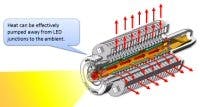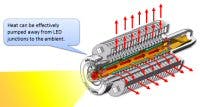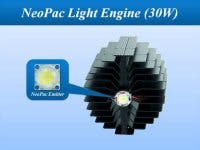NeoPac says that its emitter contains 8 chips in a single package measuring 14.1 x 14.1 mm, and that these are 40 x 40 mil (1 x 1 mm) power chips. At a forward current of 530mA, the LED power consumption is 14W, and the junction temperature (Tj) is controlled at 60°C.
“By integrating the same package (8-chips NeoPac Emitter) and a bigger thermal module, the light engine can be driven at 30W with a forward current of 1A,” a NeoPac spokesperson, Eric Yeh, told LEDs Magazine. “The Tj is also controlled at 60°C.”
The key to this thermal performance is NeoPac’s patented system-in-package (SIP) thermal management technology. “To solve the heat problem for ultra-high-power, single-package, point-light-source LEDs, the LEDs chips are mounted on a silicon submount. In turn, this submount is tightly attached onto a flat-ended heat pipe thermal dissipation module,” said Yeh.
“Our thermal management is passive cooling by natural convention,” said Yeh. “The ambient temperature is one of the key factors that affect junction temperature. Through our technology, we can easily take the heat out of the package and dissipate the heat through the heat pipe and heat sink efficiently into surrounding air.”
NeoPac has acquired live test data over 20,000 hrs for the 14W module, and estimates that the useful life (L70) of the 8-chip NeoPac Emitter when integrated on the patented thermal module is over 60,000 hrs. The 30W light engine (with a larger thermal module) is likely to have a shorter L70 because the LEDs are driven at higher forward-current density.







